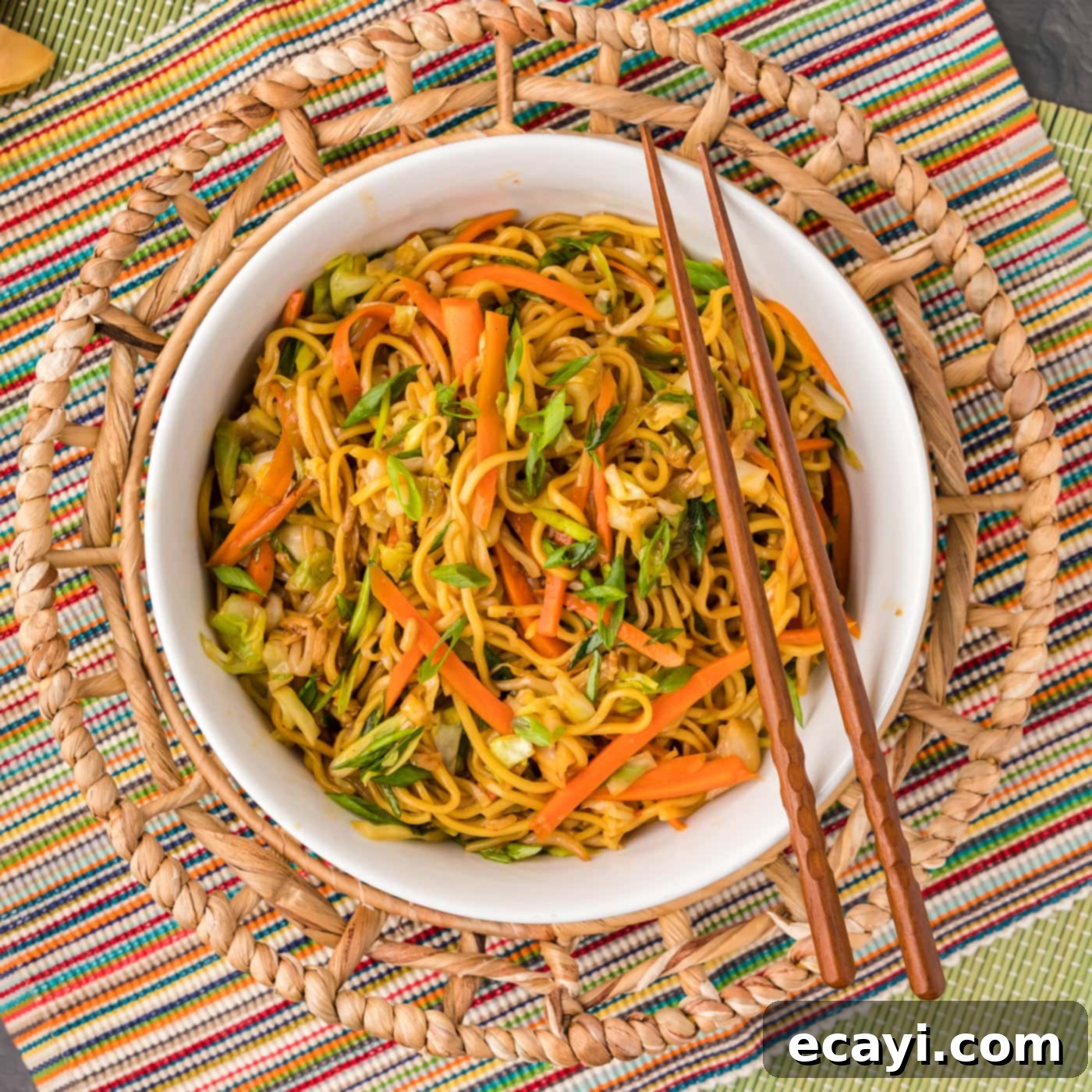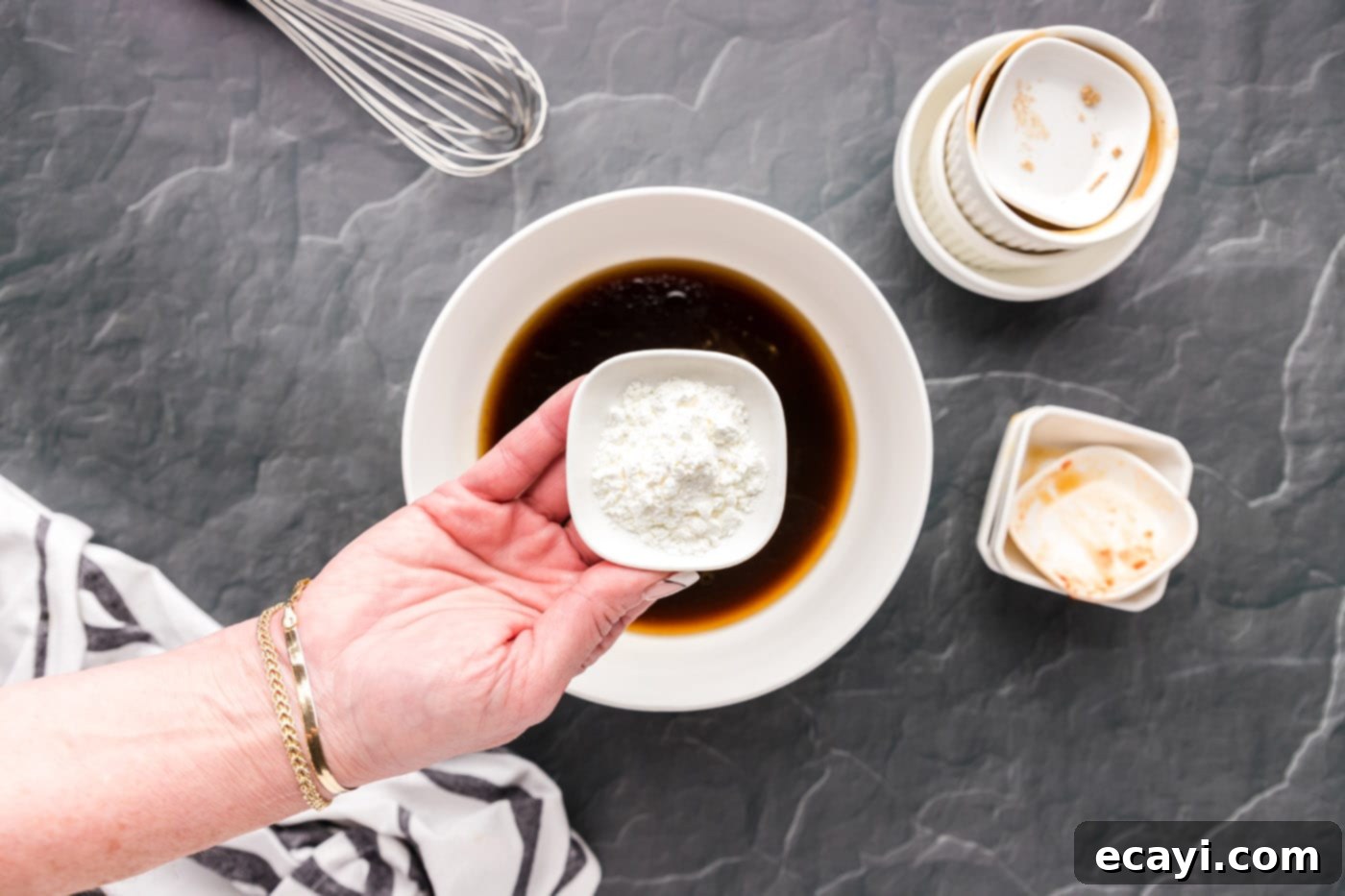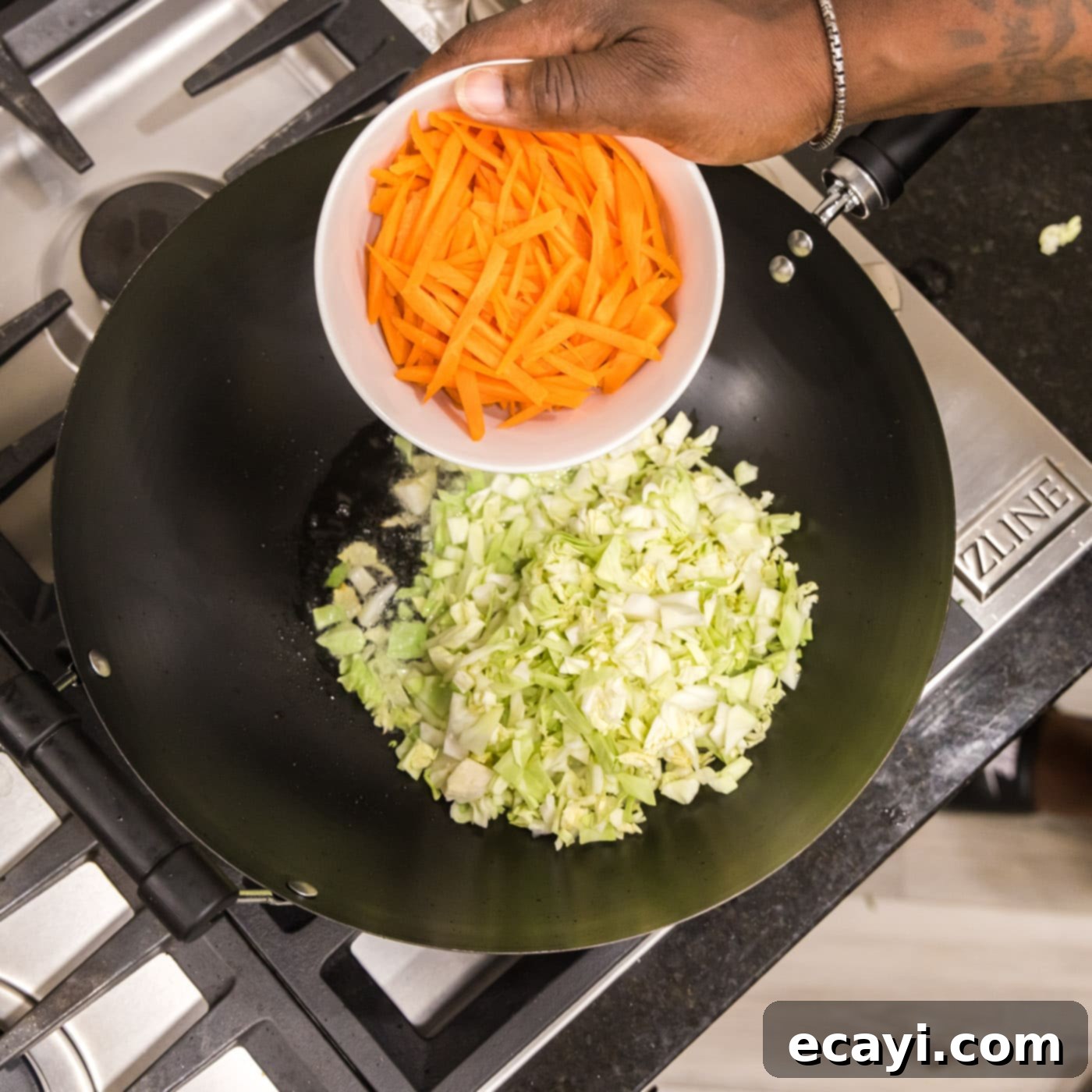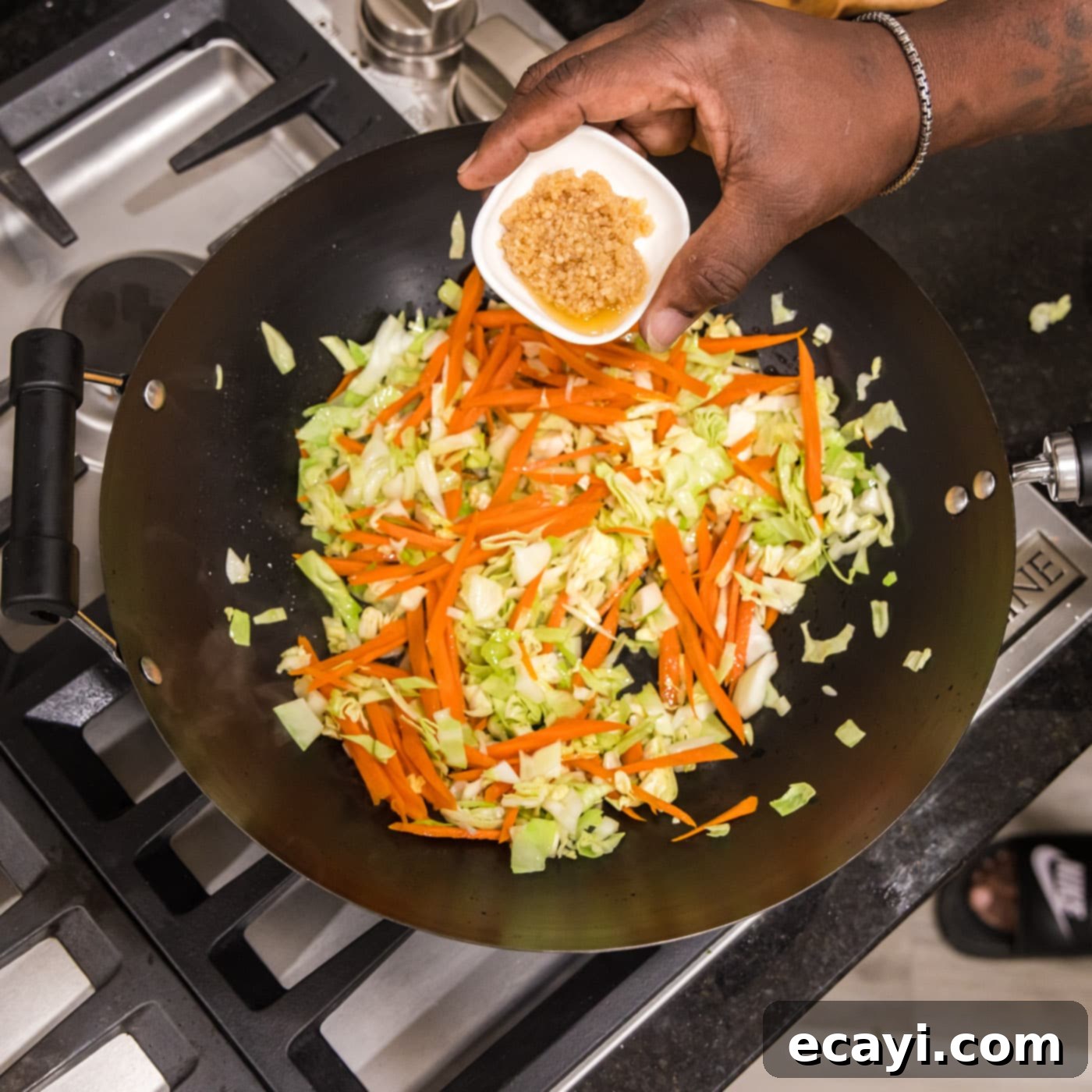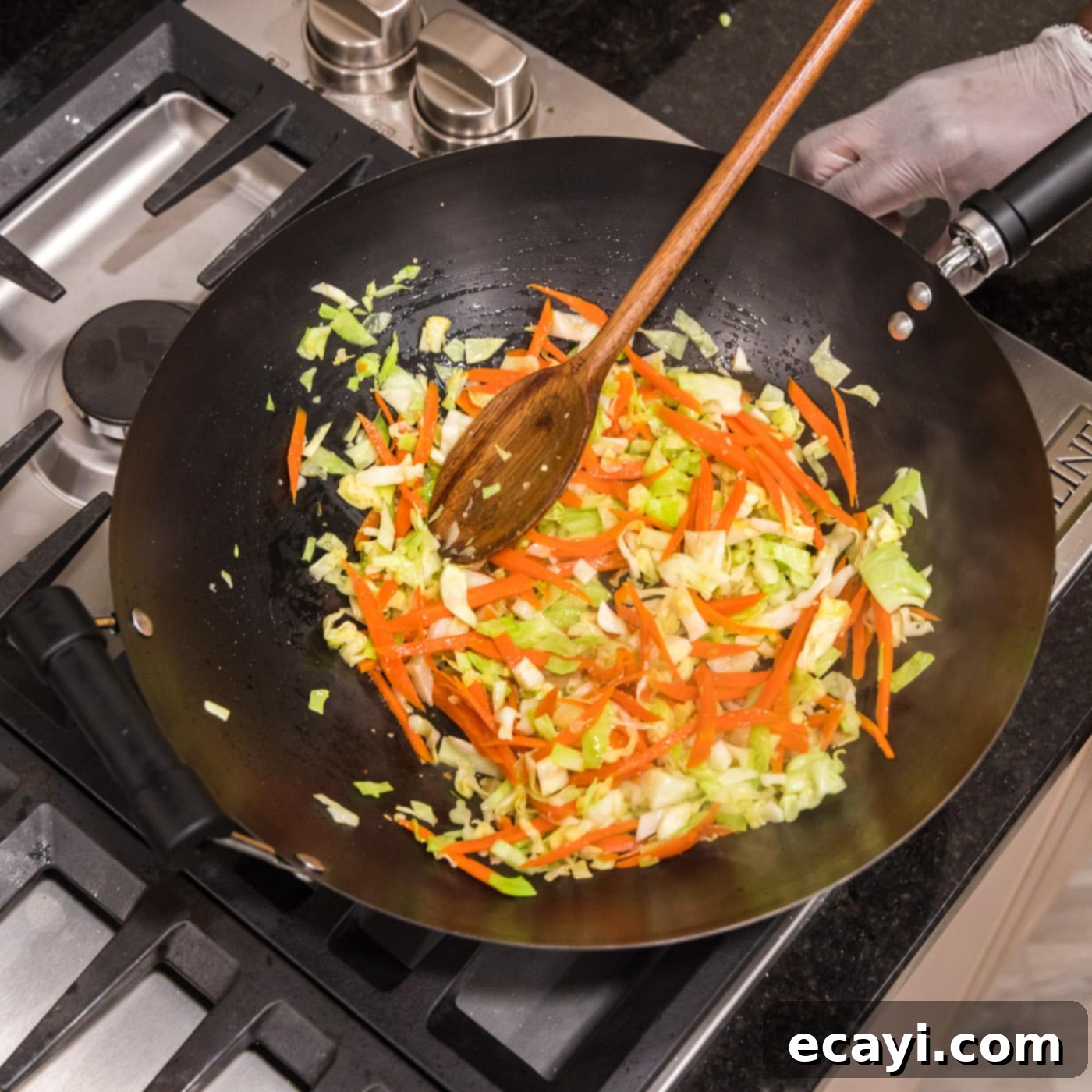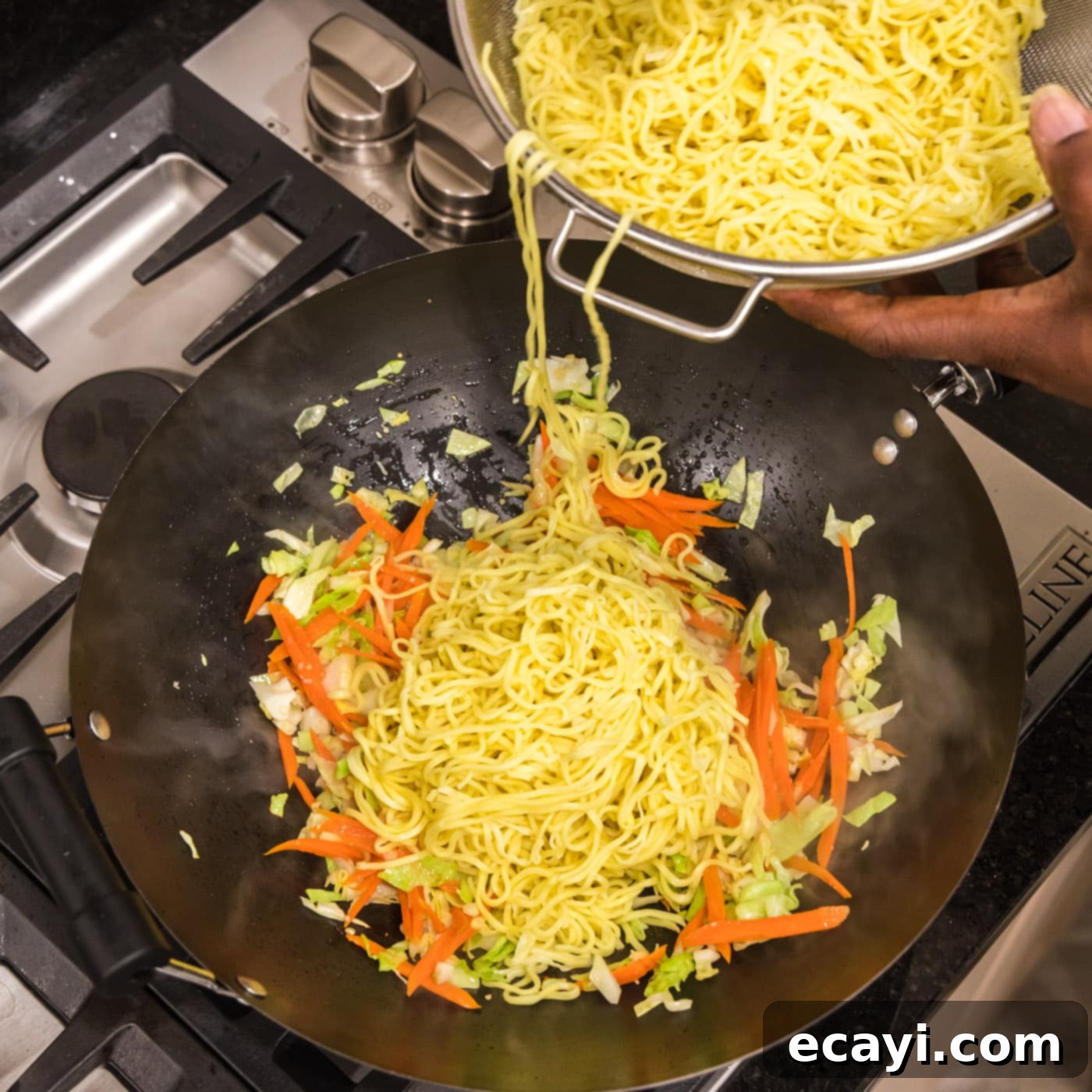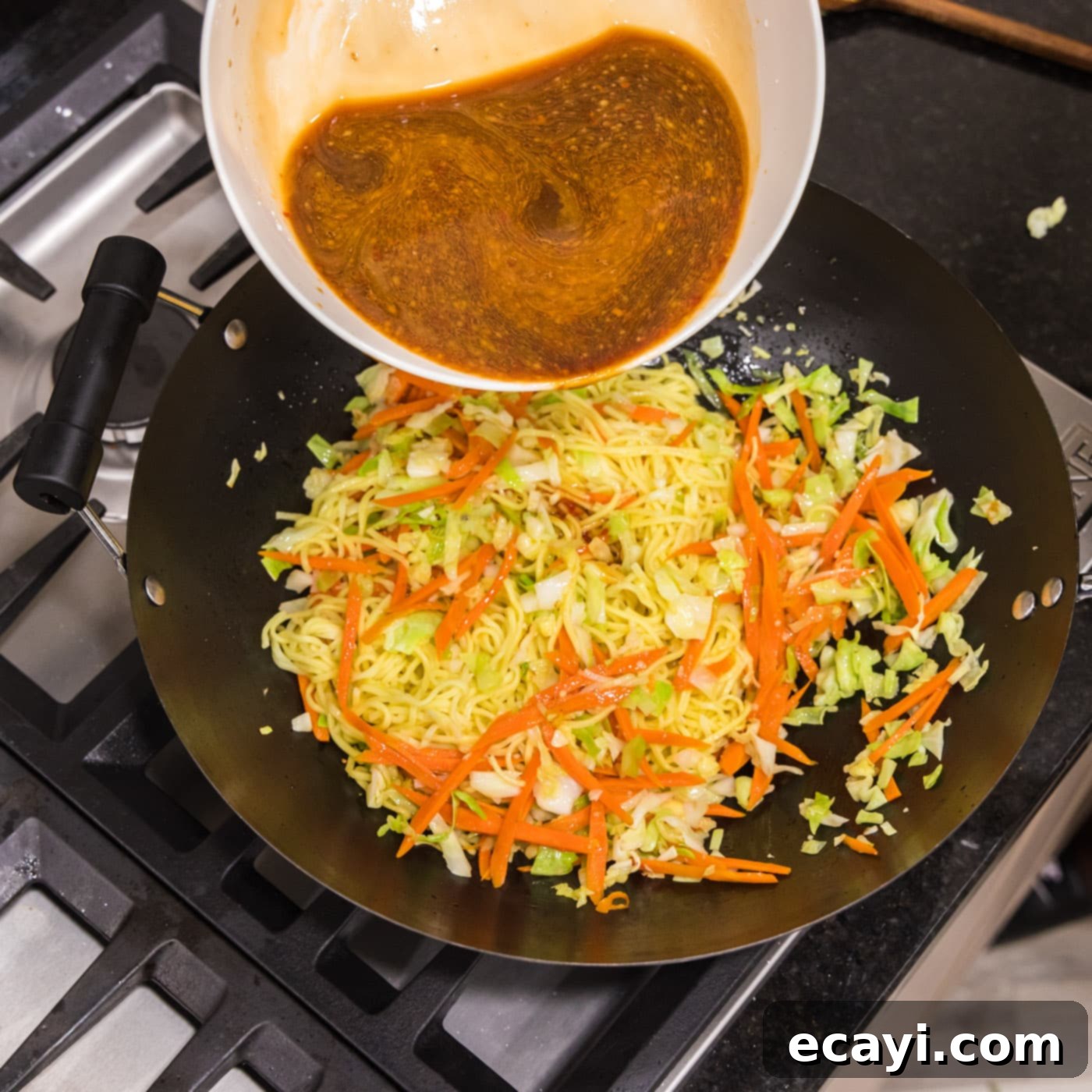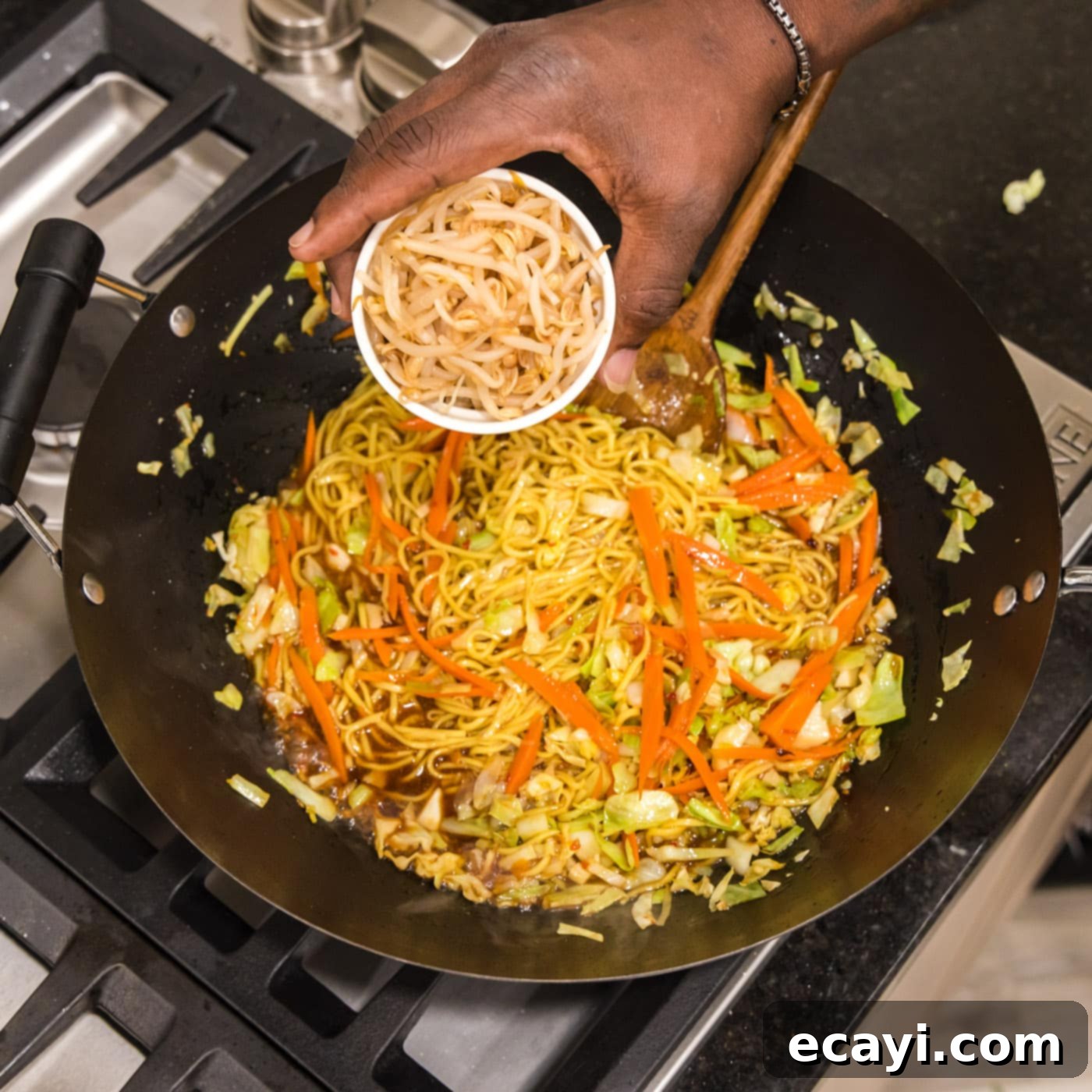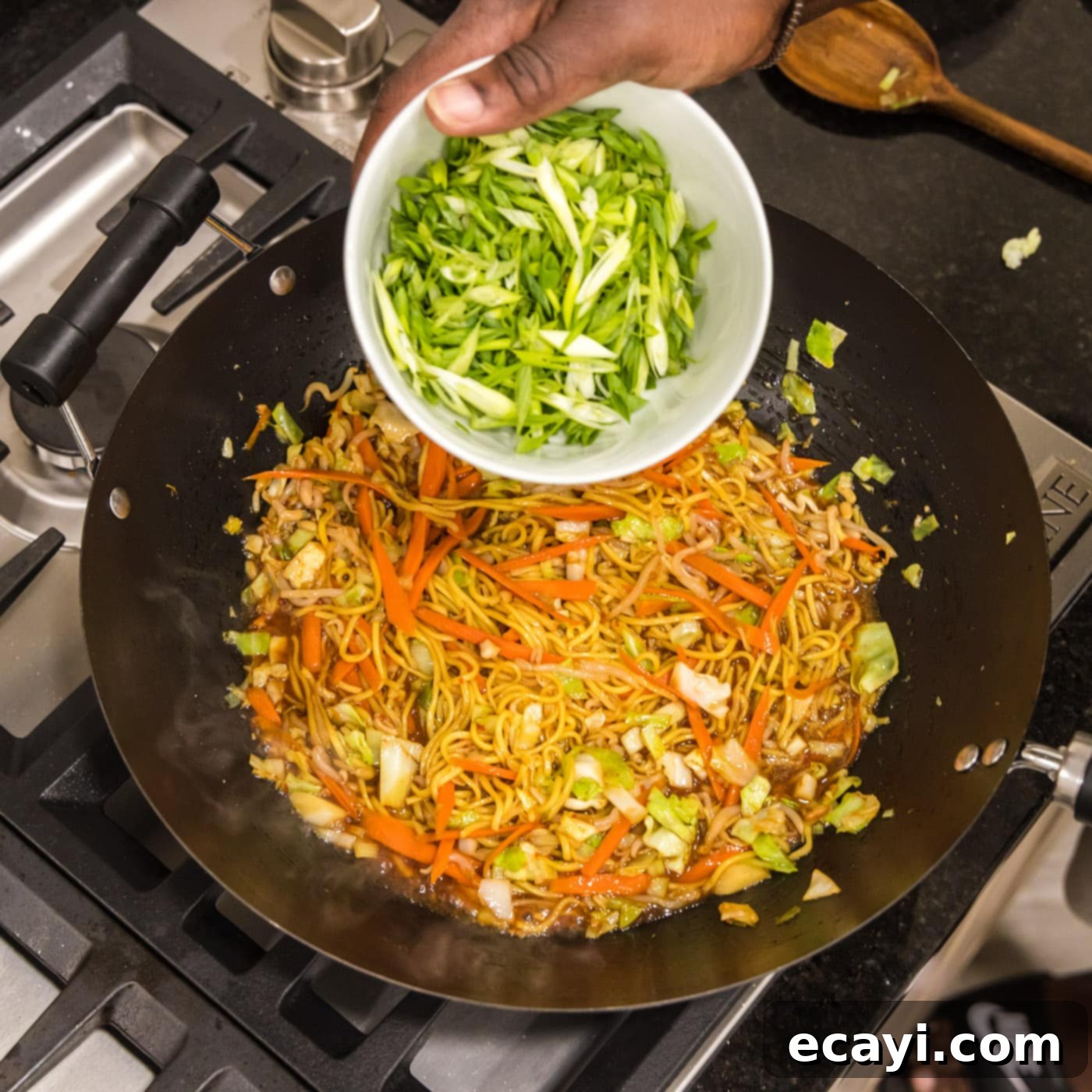Quick & Easy Homemade Chow Mein: The Best 20-Minute Recipe for Authentic Chinese Stir-Fried Noodles
Craving the delicious, savory flavors of your favorite Chinese takeout but want something fresh and fast? This effortless homemade chow mein recipe is your answer! In just 20 minutes, you can create a vibrant, satisfying dish featuring perfectly stir-fried noodles, crisp cabbage, sweet carrots, crunchy bean sprouts, and fresh green onions, all coated in an irresistible oyster-soy sauce. Forget the wait and the extra grease – get ready to enjoy the ultimate comfort food, made right in your own kitchen.
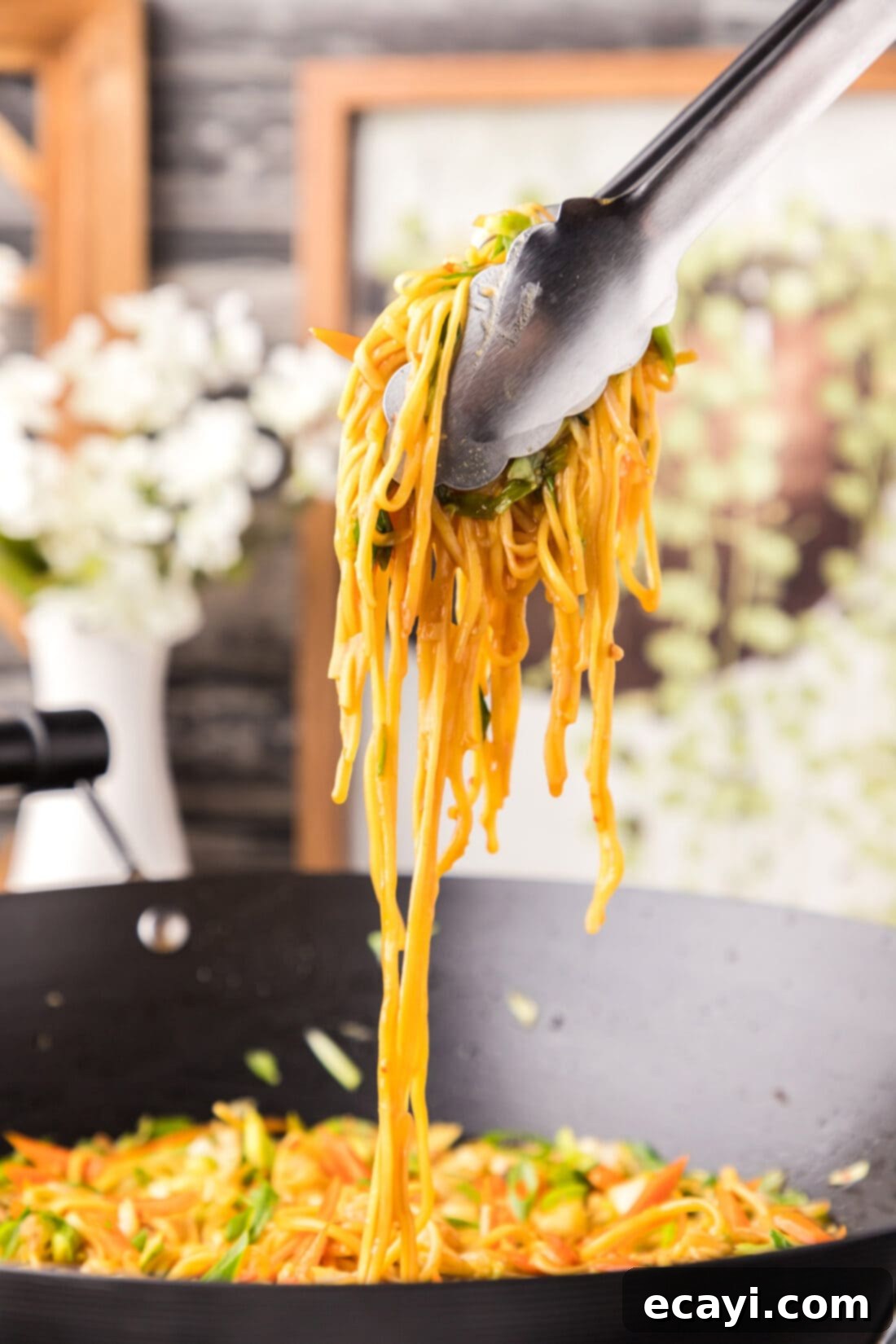
Why This Homemade Chow Mein Recipe is a Must-Try
Chow mein, a beloved Chinese dish renowned for its stir-fried noodles, crisp vegetables, and often tender meats, is a staple on takeout menus worldwide. Our version elevates this classic, bringing authentic flavors and textures directly to your dinner table in record time. What makes this recipe truly stand out is its perfectly balanced sauce and quick preparation, delivering restaurant-quality taste without the fuss.
The secret lies in our homemade chow mein sauce, a rich blend designed to hit all the right notes: savory, subtly sweet, and packed with umami. We combine premium oyster sauce, classic soy sauce, aromatic sesame oil, a touch of dark maple syrup for depth, vegetable stock for body, brown sugar for a hint of sweetness, and Asian chili sauce for a gentle kick. A touch of cornstarch ensures the sauce clings beautifully to every strand of noodle and piece of vegetable, creating a luscious glaze that defines the dish. When this incredible sauce is tossed together with al dente stir-fry noodles, fragrant garlic, and a medley of fresh, vibrant vegetables like shredded cabbage, julienned carrots, crisp bean sprouts, and bright green onions, the result is nothing short of spectacular.
This chow mein is incredibly versatile. While it makes a fantastic side dish to popular Chinese-American entrees such as General Tso’s Chicken or Chinese pepper steak, it’s hearty and satisfying enough to be enjoyed as a main course on its own. Its quick preparation time makes it an ideal weeknight meal, allowing you to bypass the wait for delivery and enjoy fresh, wholesome flavors in under half an hour. Plus, making it at home means you control the ingredients, ensuring a healthier, fresher meal free from excessive oil or artificial additives often found in commercial takeout. It’s a culinary win-win!
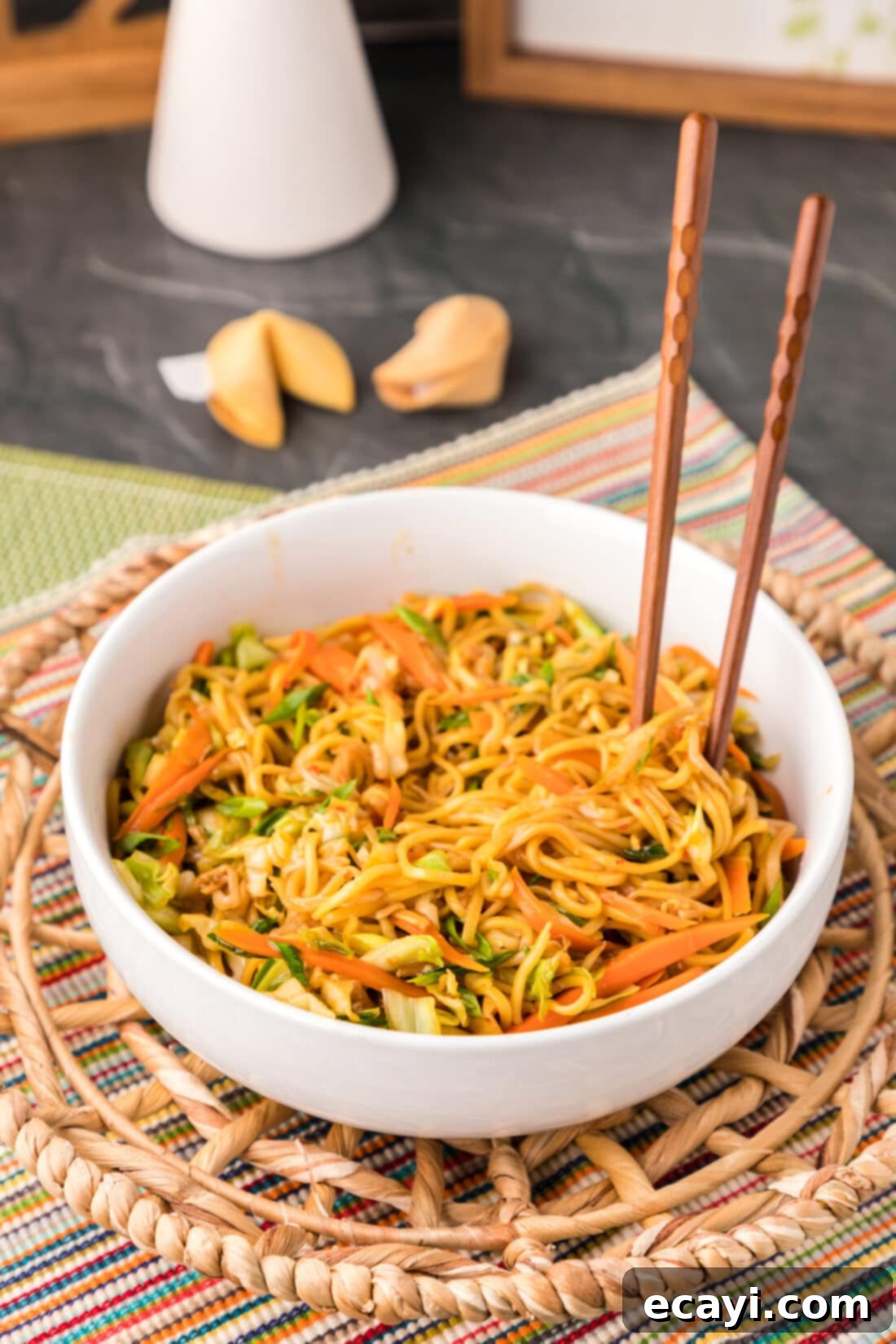
Essential Ingredients for Perfect Chow Mein
To whip up this incredible chow mein, you’ll need a selection of fresh vegetables, good quality noodles, and a few pantry staples for our signature sauce. All precise measurements and detailed instructions can be found in the printable recipe card at the very end of this post, but here’s a rundown of what you’ll gather:
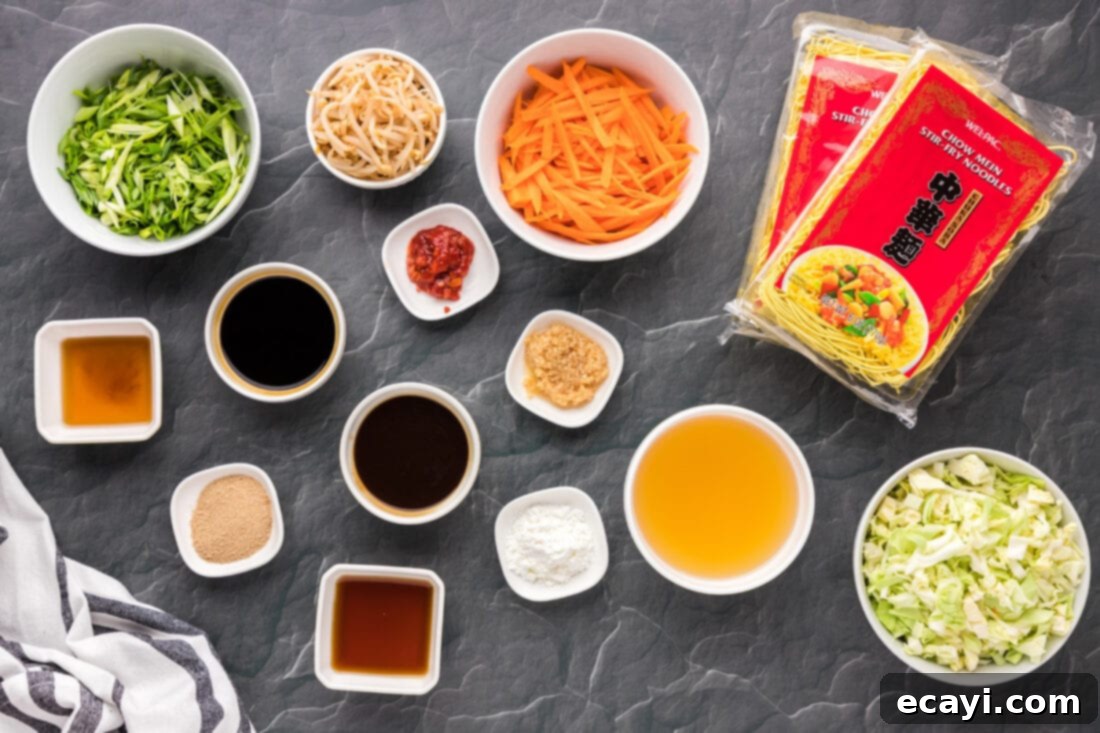
Main Ingredients:
- Chow Mein Stir Fry Noodles: The star of the show! Look for fresh or dried chow mein noodles in the international aisle.
- Olive Oil: For stir-frying the vegetables and preventing noodles from sticking.
- Minced Garlic: Fresh garlic is key for that aromatic base.
- Cabbage: Finely chopped cabbage adds a satisfying crunch and slight sweetness.
- Carrots: Julienne them for quick cooking and vibrant color.
- Bean Sprouts: Canned and drained, these add a refreshing, crisp texture.
- Green Onions: For garnish and a mild onion flavor.
For the Savory Sauce:
- Oyster Sauce: Essential for a deep, savory, umami flavor.
- Soy Sauce: The backbone of most Asian stir-fry sauces, providing saltiness and depth.
- Sesame Oil: Adds a distinct nutty aroma and flavor.
- Dark Maple Syrup: A natural sweetener that adds a rich, complex sweetness. Honey or brown sugar can be substituted.
- Vegetable Stock: To thin the sauce and add another layer of savory flavor. Chicken stock also works.
- Brown Sugar: Enhances the sweetness and helps with caramelization.
- Asian Chili Sauce: For a touch of heat, adjust to your preference. Sriracha or sambal oelek are great options.
- Cornstarch: A crucial thickening agent to give the sauce that glossy, clingy texture.
Ingredient Insights and Smart Substitutions
Understanding your ingredients and knowing when to substitute can elevate your cooking and make this recipe truly your own.
NOODLES – The cornerstone of any great chow mein. You’ll typically find chow mein noodles in the international or Asian food aisle of larger grocery stores, sometimes even next to regular pasta. They can come in fresh or dried forms. For best results, follow the package directions for cooking. Once cooked and thoroughly drained, a little trick from Chef Antoine is to toss the noodles with a small amount of olive oil. This simple step prevents them from sticking together, ensuring individual strands that stir-fry beautifully. If chow mein noodles aren’t available, you can often substitute with thin spaghetti, linguine, or even ramen noodles (discarding the seasoning packet) for a similar texture, though the authentic flavor profile will be best with dedicated chow mein noodles.
VEGETABLES – This recipe uses a classic combination of cabbage, carrots, bean sprouts, and green onions, offering a delightful mix of textures and fresh flavors. However, chow mein is incredibly adaptable to whatever vegetables you have on hand or prefer. Don’t hesitate to experiment! Excellent additions include thinly sliced celery, crisp broccoli florets, sweet baby corn, tender bok choy, snow peas, bell peppers, or even mushrooms. The key is to cut them into similar sizes (julienned, thinly sliced, or small florets) so they cook evenly and quickly in the wok. Prepping your vegetables ahead of time is crucial for stir-frying, as the cooking process itself is very fast.
SAUCE – Our oyster-soy sauce blend provides the iconic flavor. If you’re vegetarian or vegan, you can find vegetarian oyster sauce alternatives made from mushrooms. For those avoiding gluten, use tamari or a gluten-free soy sauce. Adjust the amount of chili sauce to control the heat level, or omit it entirely for a milder dish. The maple syrup adds a rich, caramel-like sweetness; if you don’t have it, a little extra brown sugar or honey can work in a pinch.
Adding Protein
While delicious on its own, chow mein is fantastic with added protein. Chicken, beef, pork, shrimp, or even tofu are excellent choices. For optimal stir-frying, slice your chosen protein into thin, bite-sized strips. Marinating the protein for 15-30 minutes beforehand in a little soy sauce, sesame oil, and cornstarch can tenderize it and infuse flavor. Brown the protein in your wok or skillet *before* adding the vegetables. Cook it until it’s just done, then remove it from the pan and set it aside. You’ll reintroduce it at the very end of the cooking process, allowing it to warm through and absorb the delicious sauce without overcooking.
Step-by-Step: Crafting Your Homemade Chow Mein
These step-by-step photos and detailed instructions are here to help you visualize how simple and satisfying it is to make this recipe. For the complete printable version of this recipe, including exact measurements and a full ingredient list, scroll down to the bottom of this post and Jump to Recipe.
Before you begin cooking, ensure all your ingredients are prepped and ready to go. Stir-frying is a very fast process, and you won’t have time to chop or measure once the heat is on. This is often referred to as “mise en place” – everything in its place!
- Prepare the Noodles: Begin by cooking your chow mein noodles according to the specific package directions. Different brands and types (fresh vs. dried) may have varying cooking times. Once cooked to al dente perfection, drain them thoroughly. Then, rinse them under cold water to stop the cooking process and remove excess starch, which helps prevent sticking. Set the noodles aside, perhaps tossing them with a tiny bit of olive oil as Chef Antoine recommends.
- Whisk the Sauce: In a medium-sized bowl, combine all the sauce ingredients: oyster sauce, soy sauce, sesame oil, dark maple syrup, vegetable stock, brown sugar, Asian chili sauce, and cornstarch. Whisk vigorously until all ingredients are well combined and the cornstarch has dissolved completely. This ensures a smooth, lump-free sauce that thickens beautifully in the wok.

- Heat the Wok: Place a large wok or a spacious skillet over medium-high heat. Add 2 tablespoons of olive oil. Allow the oil to heat until it’s shimmering and just beginning to smoke lightly. This indicates it’s hot enough for proper stir-frying, which locks in flavors and textures.
- Sauté the Initial Vegetables: Add the chopped cabbage and julienned carrots to the hot wok. Sauté these firmer vegetables for 2-3 minutes, stirring constantly. You’re looking for the carrots to just begin to tenderize and the cabbage to soften slightly, retaining a pleasant crunch.

- Add Garlic: Introduce the minced garlic to the vegetables. Toss until it’s well combined and cook for just another minute. Be careful not to burn the garlic, as it can quickly turn bitter. You want to release its fragrant aroma into the dish.


- Combine with Noodles: Add the cooked and drained noodles to the wok with the sautéed vegetables. Toss everything together vigorously, ensuring the vegetables are evenly distributed among the noodles.

- Pour in the Sauce: Give your prepared sauce one last quick whisk (as cornstarch can settle) and pour it over the noodles and vegetables in the wok. Toss continuously to coat everything evenly. The sauce will quickly begin to thicken and become glossy, creating that signature chow mein sheen.

- Add Bean Sprouts: Stir in the drained bean sprouts. Toss to combine and cook for just one more minute. Bean sprouts are delicate and cook very quickly, so adding them towards the end preserves their crisp texture.

- Finish with Green Onions: Finally, add the chopped green onions. Give everything one last quick toss to combine.

- Serve Immediately: Remove the wok from the heat and serve your piping hot, delicious homemade chow mein without delay. Enjoy the fruits of your quick and easy labor!
Frequently Asked Questions & Expert Tips
Both chow mein and lo mein are iconic Chinese noodle dishes made with wheat flour noodles, but their preparation and texture differentiate them significantly. Lo mein noodles are typically thicker, pre-boiled, and intended to be simply tossed with the sauce and other ingredients at the end, resulting in a softer, chewier texture. The name “lo mein” literally means “tossed noodles.” Chow mein, on the other hand, means “fried noodles.” While the noodles are initially boiled, they are then stir-fried in a hot wok, which gives them a slightly firmer bite and can even achieve some crispy edges if desired. The noodles are cooked directly with the vegetables and sauce, allowing them to absorb more flavor and achieve that characteristic stir-fried finish. It truly comes down to a matter of textural preference! If you’re leaning towards the softer, tossed noodle experience, be sure to check out our beef lo mein recipe instead.
Storing leftover chow mein is easy! Simply transfer any remaining noodles and vegetables into an airtight container. Keep it in the refrigerator, and it will stay fresh and delicious for 3-4 days. For best quality, consume within this timeframe.
Reheating chow mein is straightforward. You can use a microwave: simply place the chow mein in a microwave-safe dish and heat until thoroughly warmed, typically 1-2 minutes, stirring halfway through. To help remoisten the noodles and prevent them from drying out, I sometimes add a few drops of water before microwaving, though it’s not strictly necessary. Alternatively, you can reheat it in a skillet over medium heat on the stovetop. Add a small pinch of olive oil to the pan first, then stir-fry the chow mein until it’s hot throughout. This method often helps to restore some of the original stir-fried texture.
Absolutely! Adding a protein is a fantastic way to make this chow mein even more substantial and satisfying. This dish is incredibly versatile and pairs well with chicken, beef, pork, shrimp, or even plant-based options like tofu. For best results, slice your protein of choice into thin strips, reminiscent of classic stir-fry style. You’ll want to brown the protein in your wok or skillet *before* you add the vegetables. Cook it until it’s just cooked through, then remove it from the pan and set it aside. This prevents it from overcooking while you sauté the vegetables and noodles. Once all the other ingredients are cooked and the sauce has been added, return the cooked protein to the skillet, toss to combine, and heat through for the last minute or so.
For authentic stir-frying, a carbon steel wok is ideal because it heats quickly and evenly, distributing high heat across its surface. However, a large, heavy-bottomed skillet or a non-stick wok will also work beautifully for home cooking. The most important thing is to use a pan large enough to prevent overcrowding, allowing the ingredients to stir-fry rather than steam.
Yes, absolutely! To make dinner prep even faster, you can chop all your vegetables a day in advance and store them in airtight containers in the refrigerator. You can also whisk together all the sauce ingredients and keep it covered in the fridge. This way, when it’s time to cook, all you need to do is boil the noodles and stir-fry everything together, cutting down your active cooking time significantly.
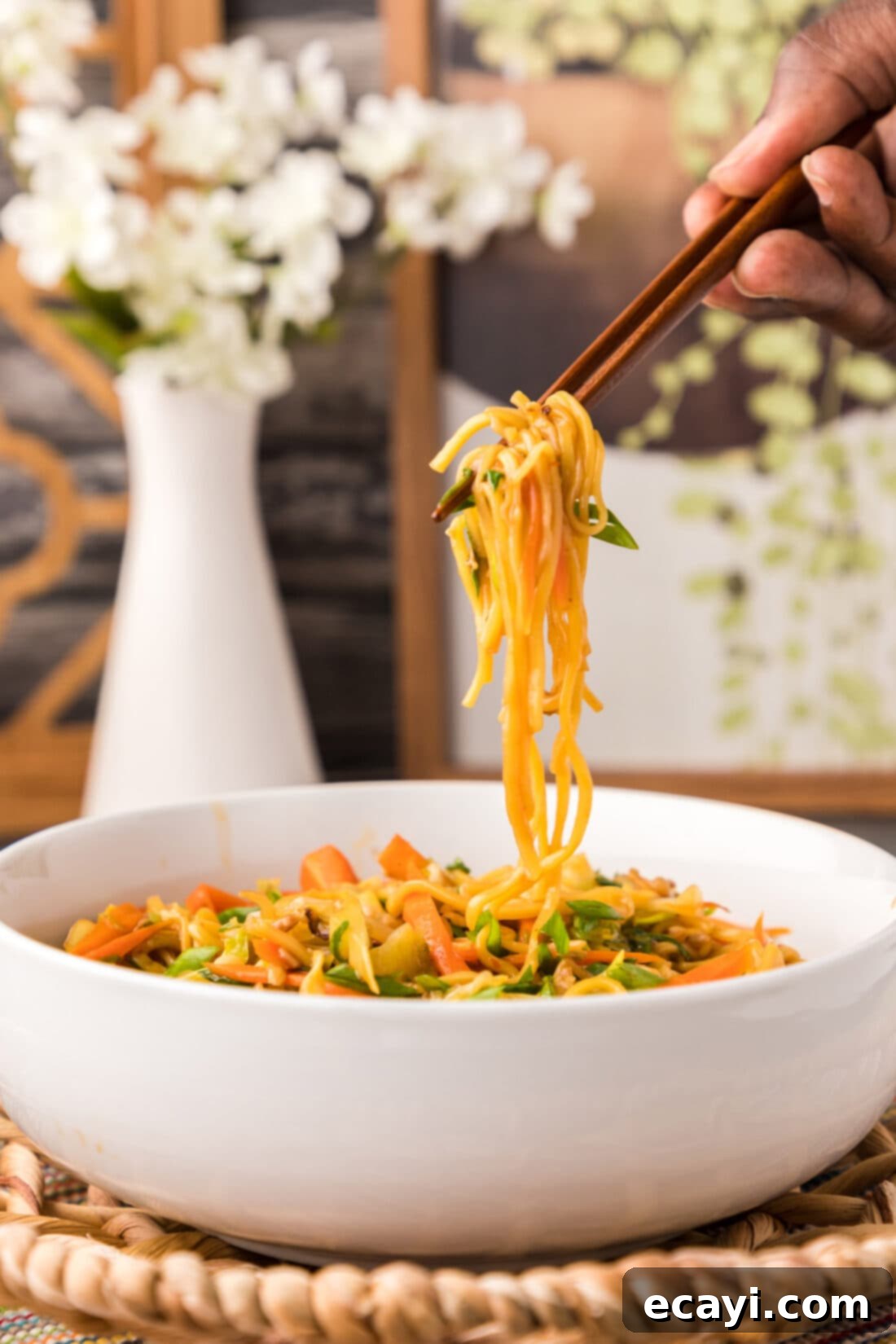
Creative Serving Suggestions for Your Chow Mein
This homemade chow mein is so flavorful and satisfying that it can easily be served as a complete meal all on its own. The combination of noodles and a variety of vegetables makes it a hearty and balanced dish. However, if you’re looking to create a more elaborate Chinese-inspired feast, it also pairs wonderfully with a range of main courses, whether they feature chicken, pork, beef, or tofu. Many people enjoy chow mein both warm and at room temperature, making it a great option for potlucks or packed lunches.
For those seeking delicious vegetarian-friendly main dishes to complement your chow mein, we highly recommend trying our delightful Sticky Garlic Cauliflower, which boasts a sweet and savory glaze, or our popular General Tso’s Cauliflower, offering a flavorful and slightly spicy kick. Either option creates a fantastic and complete meal that’s sure to impress!
Explore More Chinese-Inspired Recipes
If you loved this chow mein recipe and are eager to explore more vibrant flavors from Chinese cuisine, you’re in luck! We have a fantastic collection of dishes that are perfect for recreating your favorite takeout experiences right in your own kitchen:
- Sesame Chicken: A classic crispy chicken dish coated in a sweet and savory sesame sauce.
- Beef Lo Mein: Tender beef and soft noodles tossed in a rich, savory sauce.
- Egg Drop Soup: A comforting and light soup, perfect as a starter.
- Szechuan Beef: A spicy and bold dish featuring tender beef and fiery Szechuan flavors.
- Kung Pao Chicken: A popular spicy, stir-fried dish with chicken, peanuts, and vegetables.
I’m passionate about baking and cooking, and I truly enjoy sharing my culinary experiences with all of you! Remembering to revisit the blog daily for new recipes can sometimes be tricky, which is why I offer a convenient newsletter delivered right to your inbox every time a new recipe is posted. Simply subscribe here and start receiving your free daily recipes, ensuring you never miss out on a delicious creation!
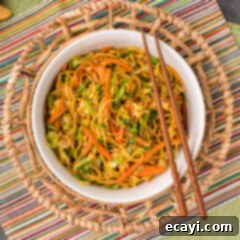
Chow Mein
IMPORTANT – For additional insights, expert tips, and frequently asked questions, please scroll back up and read through the blog post!
Print It
Pin It
Rate It
Save ItSaved!
Ingredients
- 6 ounces chow mein stir fry noodles
- 2 Tablespoons olive oil
- 1 Tablespoon minced garlic
- 2 cups cabbage chopped, measured after chopping
- 1 cup carrots julienned, measured after chopping
- ½ cup bean sprouts canned, drained
- 1 cup green onions chopped
Sauce
- ¼ cup oyster sauce
- ¼ cup soy sauce
- 1 ½ Tablespoons sesame oil
- 2 Tablespoons dark maple syrup
- ½ cup vegetable stock
- 1 Tablespoon brown sugar
- ½ Tablespoon Asian chili sauce
- 1 Tablespoon cornstarch
Equipment You’ll Need
-
Wok or large skillet
-
Wooden spoon
Before You Begin & Pro Tips
- Prevent Sticking: After cooking and draining your noodles, Chef Antoine suggests tossing them with a small amount of olive oil. This simple step helps prevent the noodles from clumping together, ensuring they stir-fry perfectly.
- Storage: Store any leftover chow mein in an airtight container in the refrigerator for up to 3-4 days. For optimal freshness, consume within this period.
- Reheating: Reheat leftovers in the microwave until warmed through, or gently in a skillet over medium heat with a tiny pinch of olive oil. When using the microwave, adding a few drops of water can help remoisten the noodles and other ingredients, though it’s not always essential.
- Adding Protein: To incorporate protein like chicken, beef, pork, shrimp, or tofu, slice it into thin, stir-fry-style strips. Brown the protein in your wok or skillet first, then set it aside. Once the vegetables and noodles are cooked and the sauce is added, return the cooked protein to the skillet to heat through and coat with the delicious sauce.
Instructions
-
Cook chow mein noodles according to package directions. Drain, rinse in cold water, and set aside.
-
In a medium bowl, whisk to combine all sauce ingredients (oyster sauce, soy sauce, sesame oil, dark maple syrup, vegetable stock, brown sugar, Asian chili sauce, and cornstarch).
-
In a wok or large skillet over medium-high heat, heat 2 tablespoons olive oil until shimmering.
-
Add chopped cabbage and julienned carrots and sauté for 2-3 minutes, until carrots begin to tenderize and cabbage softens slightly.
-
Add minced garlic, toss until combined, and cook for another minute, until fragrant.
-
Add the cooked noodles to the wok and toss to combine with the vegetables.
-
Pour the whisked sauce over the noodle and vegetable mixture and toss to thoroughly coat everything. The sauce will thicken quickly.
-
Add the drained bean sprouts and toss to combine, cooking for one more minute to warm them through while retaining their crispness.
-
Finally, add the chopped green onions and toss one last time to incorporate.
-
Remove from heat and serve your delicious homemade chow mein immediately.
Nutrition Information
The recipes on this blog are tested with a conventional gas oven and gas stovetop. It’s important to note that some ovens, especially as they age, can cook and bake inconsistently. Using an inexpensive oven thermometer can assure you that your oven is truly heating to the proper temperature. If you use a toaster oven or countertop oven, please keep in mind that they may not distribute heat the same as a conventional full sized oven and you may need to adjust your cooking/baking times. In the case of recipes made with a pressure cooker, air fryer, slow cooker, or other appliance, a link to the appliances we use is listed within each respective recipe. For baking recipes where measurements are given by weight, please note that results may not be the same if cups are used instead, and we can’t guarantee success with that method.
